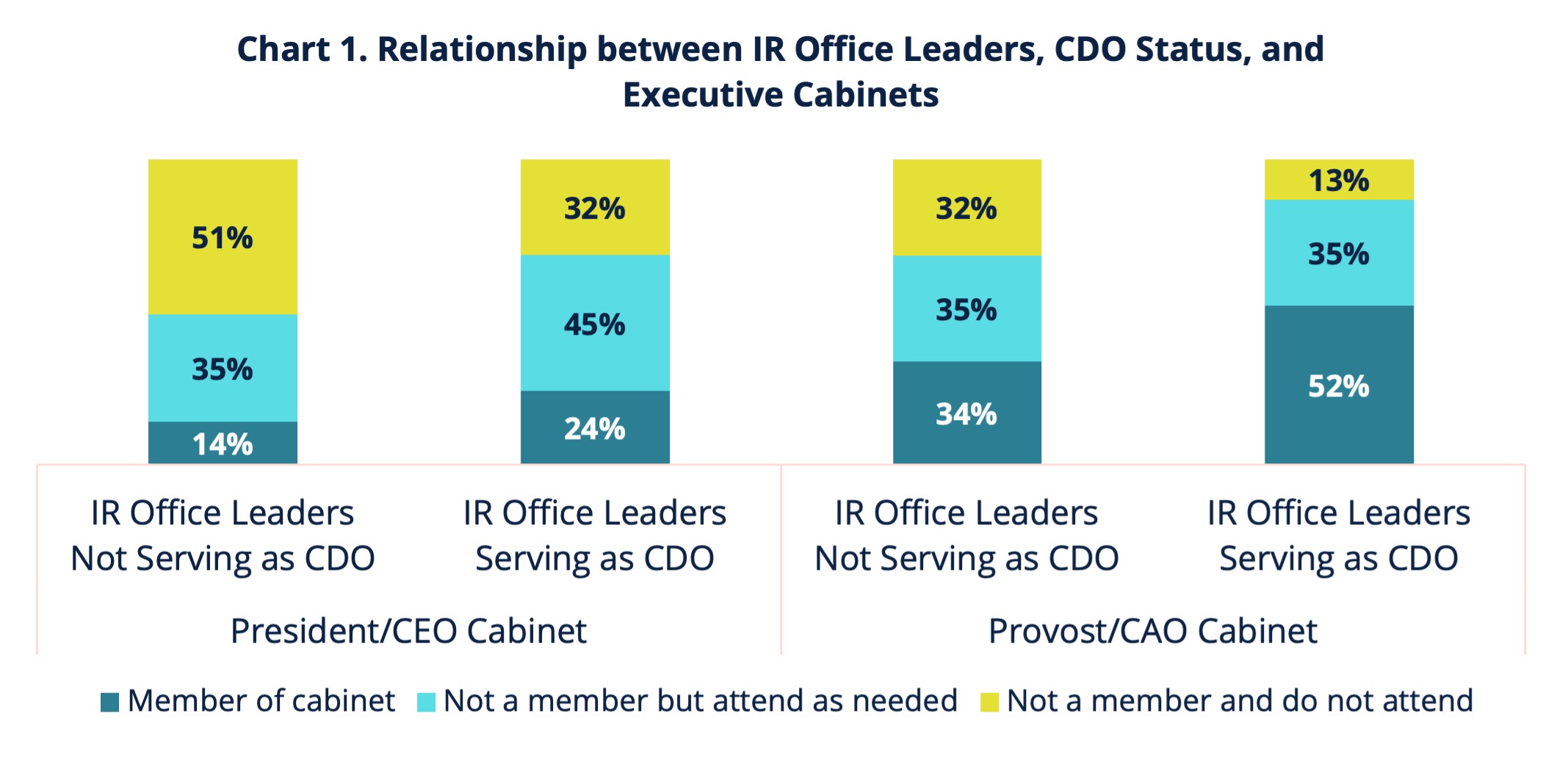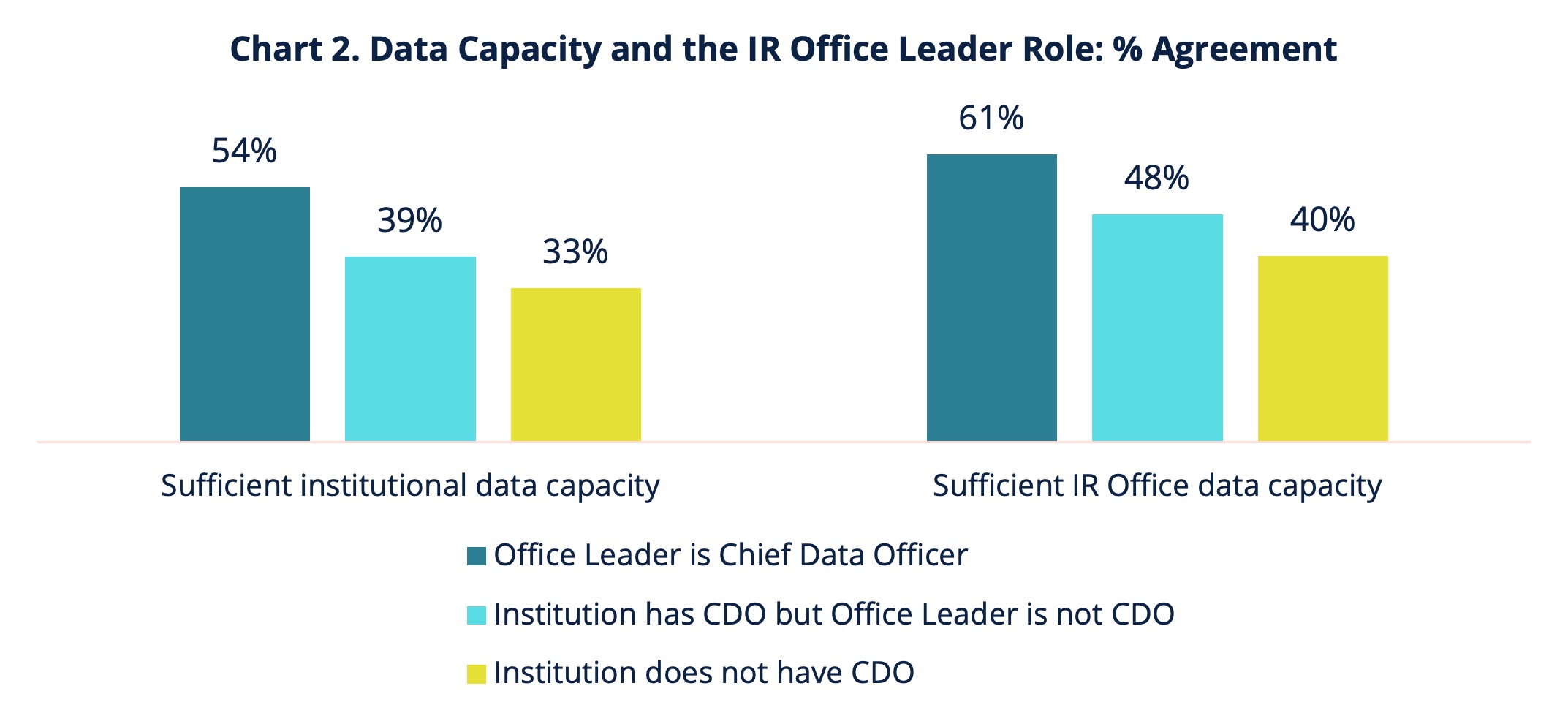Executive Leadership for the Data and Analytics Function
This brief is one of a series of reports. Learn more at airweb.org/nationalsurvey.
The AIR Statement of Aspirational Practice for Institutional Research (2016)1 and A New Vision for Institutional Research (2016)2 call for executive leadership of the data and analytics function, such as a chief data officer (CDO). We included questions in the 2018 AIR National Survey of IR Offices to explore how institutions are answering the call, what proportion of institutional research (IR) office leaders fill the CDO role (or similar), and how serving in the CDO position (or similar) influences the IR office leaders’ evaluations of institutional data capacity.
Chief Data Officer
Overall, fewer than half of institutions currently have CDO positions (Table 1). This varies across the major institutional sectors:3 public 4-year, public 2-year, and private not-for-profit 4-year. More public 2-year institutions have this position than 4-year institutions (public or not-for-profit).
Of the institutions that have CDO positions, regardless of sector, the majority are filled by IR office leaders.
| Prevalence of Chief Data Officer Position | All Institutions (n = 532) | Public 4-year (n = 159) | Public 2-year (n = 122) | Private NFP 4-year (n = 251) |
|---|---|---|---|---|
| % Institutions with Chief Data Officer (CDO) Position | 44% | 44% | 53% | 40% |
| Of those institutions, % of IR Office Leaders serving as CDO | 86% | 86% | 86% | 86% |
Executive Cabinets
We found that IR office leaders who also serve as their institutions’ CDOs are more likely to be members of the cabinets of the president/chief executive officer (CEO) or provost/chief academic officer (CAO) than those who do not serve as CDOs (Chart 1).
Of the institutions represented in the survey, 91% of IR office leaders indicated that the ideal would be to report to the president, provost, or independent IR/IE/planning unit. Upon further examination, we found that although more than half of IR offices currently report to the provost, fewer consider that ideal (Table 2).

We found similar results when we disaggregated by institutional sector (Table 2). IR office leaders at public 2-year institutions who are also their institutions’ CDOs are more likely to serve on the president’s cabinet than CDOs in other sectors.
| Table 2. Relationship between IR Office Leaders, CDO Status, and President/CEO Cabinet by Sector | All Institutions | Public 4-year | Public 2-year | Private NFP 4-year |
|---|---|---|---|---|
| Office Leaders Not Serving as CDO | ||||
| Member of cabinet | 14% | 7% | 33% | 10% |
| Not a member but attend as needed | 35% | 43% | 33% | 31% |
| Not a member and do not attend | 51% | 49% | 34% | 58% |
| Office Leaders Serving as CDO | ||||
| Member of cabinet | 24% | 12% | 47% | 17% |
| Not a member but attend as needed | 45% | 45% | 35% | 51% |
| Not a member and do not attend | 32% | 43% | 18% | 32% |
Findings were similar for provost cabinets (Table 3). In this case, IR office leaders at 4-year institutions, public and private not-for-profit, who serve as their institutions’ CDOs are more likely to be members compared to those at public 2-year institutions.
| Relationship between IR Office Leaders, CDO Status, and Provost/CAO Cabinet | All Institutions | Public 4-year | Public 2-year | Private NFP 4-year |
|---|---|---|---|---|
| Office Leaders Not Serving as CDO | ||||
| Member of cabinet | 34% | 29% | 36% | 37% |
| Not a member but attend as needed | 35% | 40% | 39% | 29% |
| Not a member and do not attend | 32% | 31% | 25% | 34% |
| Office Leaders Serving as CDO | ||||
| Member of cabinet | 52% | 57% | 48% | 51% |
| Not a member but attend as needed | 35% | 35% | 40% | 31% |
| Not a member and do not attend | 13% | 8% | 13% | 18% |
Executive Leadership and Data Capacity
We asked IR office leaders to evaluate institutional and IR office data capacity by indicating their levels of agreement with the following two statements:
- There is sufficient capacity across the institution to meet stakeholders’ needs for data and information for decision making.
- There is sufficient capacity within the IR Office to meet stakeholders’ needs for data and information for decision making.
Disaggregating the data by role, we found that a higher percentage of IR office leaders who serve as CDOs agreed with these two statements than office leaders who are not in that role (Chart 2). Further, even when CDO roles exist, but IR office leaders do not fulfill those roles, IR office leaders agreed with these statements more than office leaders at institutions without CDOs.

Methodology
The 2018 AIR National Survey of IR Offices attempted to survey IR office leaders at more than 3,000 postsecondary degree-granting institutions. Institutions of all sectors, types of control, and sizes were included in the sample. In total, responses represented 1,167 institutions, and 566 of those institutions completed the survey in full. To ensure comparable results, incomplete responses are excluded from this report. In addition, responses from for-profit institutions, administrative units, international institutions, private not-for-profit 2-year institutions, and institutions in U.S. territories are excluded due to low response rates.
This Report
The findings presented in this report are based on 543 responses that represent U.S. postsecondary, degree-granting institutions at public 4-year, public 2-year, or private not-for-profit 4-year institutions.
- Swing, R. L., & Ross, L. E. (2016). Statement of aspirational practice for institutional research. Tallahassee, FL: AIR. http://www.airweb.org/aspirationalstatement
- Swing, R. L., & Ross, L. E. (2016, March/April). A new vision for institutional research. Change: The Magazine of Higher Learning, 6-13. https://www.airweb.org/resources/publications/studies-and-reports/a-new-vision-for-institutional-research
- See methodology section at end of this report for more information.
Related Content
2018 AIR National Survey of IR Offices: Topic Briefs
